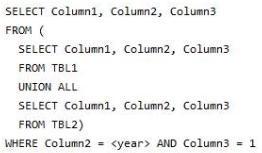Note: This question-is part of a series of questions that use the same or similar answer choices. As answer choice may be correct for more than one question-in the series. Each question-is independent of the other questions in this series.
Information and details provided in a question-apply only to that question.
You have a Microsoft SQL Server database named DB1 that contains the following tables:

Users frequently run the following query. The users report that the query takes a long time to return results.

You need to minimize the amount of time required for the query to return data.
A. Create clustered indexes on TBL1 and TBL2.
B. Create a clustered index on TBL1.Create a nonclustered index on TBL2 and add the most frequently queried column as included columns.
C. Create a nonclustered index on TBL2 only.
D. Create UNIQUE constraints on both TBL1 and TBL2. Create a partitioned view that combines columns from TBL1 and TBL2.
E. Drop existing indexes on TBL1 and then create a clustered columnstore index. Create a nonclustered columnstore index on TBL1.Create a nonclustered index on TBL2.
F. Drop existing indexes on TBL1 and then create a clustered columnstore index. Create a nonclustered columnstore index on TBL1.Make no changes to TBL2.
G. Create CHECK constraints on both TBL1 and TBL2. Create a partitioned view that combines columns from TBL1 and TBL2.
H. Create an indexed view that combines columns from TBL1 and TBL2.


I agree on G
Correct Answer: G